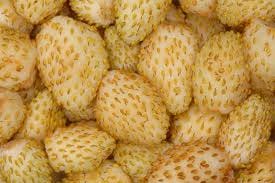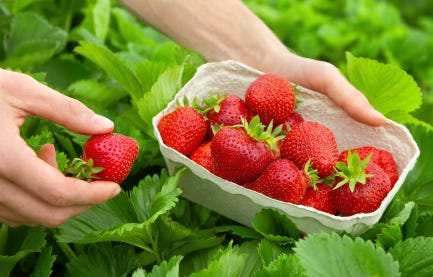Growing Strawberries and Fruiting Season Tips
I love strawberries and am sharing my preparation and amendment methods to grow yourself some of the best strawberries you've ever had. Mouth watering, ripe, juicy and delicious strawberries!
Select a site in full sun with good drainage.
Avoid boggy and low areas that don't have good drainage and have had nightshade family plants growing there for 3 years or more prior to claiming your bed. Nightshade / Solanaceae family plants include: eggplant, pepper, potato, tobacco, tomatillo, tomato, datura, mandrake, petunia, belladonna, goji berries, goose berries, and capsicum / cayenne.
Raised beds can work great, and so can planting on ridges and hillsides.
Keep plants cool and moist prior to planting, and plant your strawberries on a cool and cloudy day if possible.
When you start working the soil make sure to dig deep and turn it all over well. After you have done that, make sure you amend and/or fertilize it, and then turn that in good again, making sure everything is mixed well and broken up.
Using a tiller is the most ideal because this will mix everything more quickly and also more finely than doing it manually with a shovel, pick axe, hoe and/or hula hoe. If you don't have a tiller or prefer to do it manually, you can get just as good results. I do most of my jobs in this regard without a tiller and get excellent results, good drainage, and a good mix with my amendments and fertilizers.
After you do all this, you are now ready to plant your strawberry starts and water them in.
If you want relatively continuous crops throughout the growing season get day-neutral varieties. Ever-bearers produce few runners and 2 crops a year... one in June and one in the fall. June-bearers... as the name suggest... produce only one crop a year and offer you flowers, fruits and runners and... you guessed it... only bear fruit in June.
Another variety I worked with recently is the White Alpine Strawberry. It grows well here in the Rogue Valley and has a delicious pineapple like taste that is tangy and bursting with zing. This is a wild strawberry variety.
Wild food in any category, whether it be vegetable, fruit or herb, by nature is usually easier to grow in the climate it is native to. You also get the benefit of wild food being more nutritious and richer in minerals than cultivated foods. When you enrich your soil in the ways I teach here, this changes the game and makes for vitamin and mineral rich food, even if what we are growing in your garden isn't a wild or heirloom variety of plant.
Excellent Amendment for Strawberries
I planted the strawberries I discovered this recommendation with on a gravely hillside with outstanding drainage, but poor soil because of it being mostly gravel, clay, and decomposed granite.
I dug and cut out starts from a pre-existing strawberry bed, and transplanted them into holes on this gravely hillside. Spacing them all a minimum 10 to 12 inches apart, and filled each hole generously with this Gardener & Bloome planting mix when transplanting the rooted cuttings.
I watered them in very well. Watering thoroughly is always recommended when planting and transplanting.
In about 2 to 4 weeks we had some of the best strawberries I've ever had.
I get the results I get because I know that the ground is the foundation of the quality, health, and taste of your garden. This timeless wisdom goes right with the approach that...if something works, stick with it, and if something isn't broken, don't fix it. Care for it, protect it, and sustain it by giving it the nourishment it needs. By doing this, you help to encourage and build the health and strength of your plants.
Cheers to growing yourself some outstanding strawberries, and making this year one of the best years ever in your garden!
Fruiting Season Considerations
When your berries and fruit tress are fruiting, I suggest watering them a bit more than usual. Since fruit is composed of high water content, it is ideal to provide adequate water to optimize your fruits to help make them as juicy as possible.
A good way to do this is by hand watering the feeder roots (where applicable) that make a perimeter extending out 5 to 10+ feet (depending on the size of your tree) from the base of your trees/shrubs, where the trunk meets the soil. If you have them on irrigation, you can kick up the time to be a minimum of 10 minutes a day or 15 minutes every other day.
Straight Up & Free with James D is a reader supported publication.
If you found this valuable and educational, and appreciate the craftsmanship and care I bring in providing this content, please consider upgrading your subscription to support my work. You can also give a gift subscription, or make a one time donation.
Thank you!




